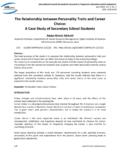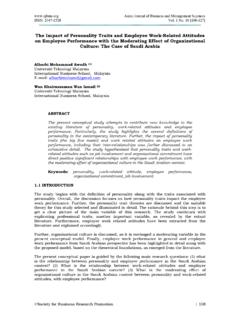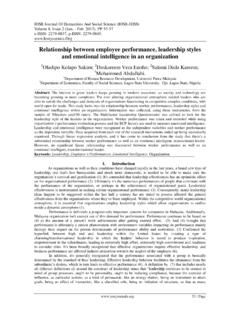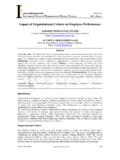Transcription of Refining the Relationship Between Personality and ...
1 Refining the Relationship Between Personality and subjective Well-BeingPiers Steel, Joseph Schmidt, and Jonas ShultzUniversity of CalgaryUnderstanding subjective well-being (SWB) has historically been a core human endeavor and presentlyspans fields from management to mental health. Previous meta-analyses have indicated that personalitytraits are one of the best predictors. Still, these past results indicate only a moderate Relationship , weakerthan suggested by several lines of reasoning. This may be because ofcommensurability, whereresearchers have grouped together substantively disparate measures in their analyses. In this article, theauthors review and address this problem directly, focusing on individual measures of Personality ( ,the Neuroticism-Extroversion-Openness Personality Inventory; P. T. Costa & R. R. McCrae, 1992) andcategories of SWB ( , life satisfaction). In addition, the authors take a multivariate approach, assessinghow much variance Personality traits account for individually as well as together.
2 Results indicate thatdifferent Personality and SWB scales can be substantively different and that the Relationship Between thetwo is typically much larger ( , 4 times) than previous meta-analyses have indicated. Total SWBvariance accounted for by Personality can reach as high as 39% or 63% disattenuated. These results alsospeak to meta-analyses in general and the need to account for scale differences once a sufficient researchbase has been : Personality , subjective well-being, meta-analysis, commensurabilitySubjective well-being (SWB) is a fundamental human at least the sixth century , the Classic Greeks exploredthe issue under the rubric ofeudaemonia,that is human flourishingor living well. This followed with the Hellenistic Greeks and theRomans exploringataraxia, a form of happiness within one s owncontrol (Leahey, 2000). Similarly, interest in SWB has continuedto the present day, also under a variety of terms and methodologies( , Diener, Eunkook, Lucas, & Smith, 1999; Lyubomirsky,Sheldon, & Schkade, 2005).
3 More recently, the study of SWB hasfocused on its Relationship to Personality , and sufficient researchhas been conducted to permit several meta-analyses (Ozer &Benet-Mart nez, 2006). In particular, DeNeve and Cooper s (1998)work, which summarizes the correlations of SWB with 137 traits,has been cited close to 200 times in fields ranging from economics(Frey & Stutzer, 2002) to gerontology (Isaacowitz & Smith, 2003).They have shown that Personality is one of the foremost predictorsof SWB, which underscores the importance of using Personality tounderstand happiness. The focus of the current meta-analysis is tobuild on this innovative research base by reexamining the rolepersonality has with major reason for this reanalysis is twofold. First, there hasbeen an explosion of interest in positive psychology in the newmillennia ( , Seligman & Csikszentmihalyi, 2000), generatingconsiderably more data since DeNeve and Cooper (1998) con-ducted their study.
4 For example, their earlier investigation of thepersonality trait Psychoticism s Relationship with SWB was basedon five samples, whereas we were able to obtain over 43 samplesfor the present meta-analysis. This allowed us to refine our esti-mates to a much greater degree. Second and more importantly,despite the frequent citations of DeNeve and Cooper s meta-analysis, as well as other summaries indicating that Personality isone of the strongest predictors of SWB, the previously establishedassociations are still weaker than expected. As DeNeve and Coo-per reported, on average, Personality variables were associatedwith [only] 4% of the variance for all indices of SWB (p. 221).Specifically, the correlations of overall SWB with the Big Fivetraits are as follows: .17 (Extraversion), .17 (Agreeableness), .21(Conscientiousness), .22 (Neuroticism), and .11 (Openness toExperience).
5 We argue that these results are substantially smallerthan those that would be expected from theoretical analyses andempirical studies, especially with regards to Extraversion, whichshould be considerably stronger than Agreeableness and begin by considering four major reasons that thepersonality SWB Relationship should be particularly strong. Afterthis, we review how the Relationship Between SWB and personalitycould be better assessed. Because of the recent proliferation ofSWB research, several improvements to the meta-analytic proce-dure are now available. To begin with, previous research wasprimarily univariate, examining the Relationship of individual traitswith SWB. We examine the multivariate impact of all majorpersonality traits simultaneously. More important, we review howpast meta-analyses aggregated dissimilar operational definitions ofPiers Steel, Human Resources and Organizational Dynamics, Universityof Calgary, Calgary, Alberta, Canada; Joseph Schmidt and Jonas Shultz,Industrial/Organizational Psychology, University of Shultz in now at the Calgary Health Region, Calgary, Alberta, would like to thank the International Well-Being Group as well asRichard Lucas, Robert Cummins, and Ruut Veenhoven specifically forproviding commentary and encouragement on a draft of this concerning this article should be addressed to PiersSteel, 444 Scurfield Hall, 2500 University Drive NW, Universityof Calgary, Calgary, Alberta T2N 1N4, Canada.
6 BulletinCopyright 2008 by the American Psychological Association2008, Vol. 134, No. 1, 138 1610033-2909/08/$ DOI: and SWB constructs, likely affecting the summaryestimates. We argue that a multivariate analytic approach thatcontrols for measurement differences should yield the most appro-priate and accurate meta-analytic effect the SWB Personality Relationship Is LikelyUnderestimatedIn the following sections, we review four arguments that suggesta far greater connection Between SWB and Personality than whatis presently found. We first note that there are strong theoreticallinkages Between Personality and SWB. Second, at a definitionalor conceptual level, there are impressive similarities Between spe-cific Personality traits and SWB components. Third, we examineresearch regarding genetic determinants of SWB. This literatureindicates that long-term SWB is largely determined by personalitytraits.
7 Fourth, we note that the situational strength does not affectthe results as would be expected. In particular, life satisfactionshould be more closely connected to SWB than job satisfaction;however, the opposite effect has been LinkagesThere are a wide variety of theoretical linkages Between per-sonality traits and SWB, prompting Diener and Lucas (1999) toconclude, it appears a substantial portion of stable SWB is due topersonality (p. 214). To briefly review, we focus on the majordirect and indirect paths, also known as the temperamental, inter-nal or top-down, and instrumental, external or bottom-up perspec-tives (Diener & Emmons, 1984; McCrae & Costa, 1991). At adirect level, we can determine whether SWB and Personality arerelated by showing that they involve common biological mecha-nisms or neural substrates. At the indirect level, we can determinewhether behaviors indicative of Personality traits are also seen tocreate there are several theories that indicate Personality hasbiological components ( , Cloninger, Svrakic, & Przbeck, 1993;H.)
8 J. Eysenck, 1967), Gray s (1987) reinforcement sensitivitytheory is particularly relevant. It indicates that two systems, abehavioral activation system (BAS) and a behavioral inhibitionsystem (BIS), are connected to both Personality and SWB (Elliot& Thrash, 2002). The BAS is linked toExtraversionand regulatesapproach behavior by signaling the presence of rewards throughthe promotion ofpositive affect. The BIS is linked toNeuroticismand regulates avoidance behavior by signaling the presence ofpunishers through the promotion ofnegative affect. Consequently,extraverts are more likely to attend to rewards and find them morepositive, whereas neurotic individuals are more likely to attend topunishers and find them more there is evidence to support Gray s (1987) theory, muchof it has been relatively circumstantial and not entirely example, there is some evidence to suggest that personalitytraits are related to mood induction and that extraverts attend moreto rewards (Carver, 2004; Matthews & Gilliland, 1999; Smits &Boeck, 2006).
9 However, in recent years, considerable advanceshave been made in the psychobiology of both SWB and person-ality. We can now make a much more direct argument demon-strating that the two constructs share common physical particular note is a pair of meta-analyses, one which directlyconnects the neurotransmitter serotonin to the Neuroticism scale ofthe Neuroticism-Extroversion-Openness Personality Inventory(NEO; Costa & McCrae, 1992; Schnika, Busch, & Robichaux-Keene, 2004) and the other that connects it to depression andaffective disorders (Lasky-Su, Faraone, Glatt, & Tsuang, 2005).Similarly, Depue and Collins (1999) reviewed considerable evi-dence that dopamine is involved in Extraversion, whereas Rolls(2000) reviewed how it facilitates the experience of rewards (seealso Pickering & Gray, 2001). Additional parallels can be drawnusing Davidson s (2005) recent review of neural substrates ofwell-being.
10 Davidson proposed that the amygdala, the prefrontalcortex, the hippocampus, and the anterior cingulated cortex canexplain well-being and affective style, and others have used thesesame mechanisms to explain Personality , in particular Extraversion(Cloninger, 2000; Depue & Collins, 1999). All in all, the overlapis considerable (Zuckerman, 2005).Moving to indirect mechanisms, Personality may help create lifeevents that influence SWB. The most replicated finding in this areais the link Between Sociability, a facet of Extraversion, and posi-tive affect (Eid, Riemann, Angleitner, & Borkenau, 2003). Thislink can operate in two fashions. First, people tend to be happier insocial situations (Pavot, Diener, & Fujita, 1990), and becauseextraverts spend more time socially (Watson, Clark, McIntyre, &Hamaker, 1992), they should be happier. Second, Extraversiongenerally has a positive impact on peer, family, and romanticrelationships, whereas Neuroticism is often a negative predictor(C.)









